[Top] [Prev] [Next] [Bottom]
Chapter 5. Action of Koji Extract Upon -Gelatinized Starch
From the point of view of the sake brewer, the change which koji solution produces in the nature of starch is of the utmost importance, and it will on that account be needful to enter into somewhat minute details concerning its action under varying conditions of time and temperature. That a remarkable change does take place will be evident to any one who adds a few cubic centimeters of a filtered solution of koji to a quantity of thick starch paste, especially if the latter be at a temperature of about 45° to 50° C. Within a very short time, a few minutes at most, the paste or jelly which before would not have moved on inverting the vessel containing it, will become as liquid as water, and if the flocks of cellulose be allowed to settle, as transparent as water. This cannot be observed in the ordinary process of manufacture, but the change takes place, it is only disguised by the presence of a considerable quantity of insoluble matter. In order, therefore, to understand the chemical reactions involved in sake brewing, the first point is to ascertain the composition of the clear, transparent solution obtained as above described.
Using malt extract instead of koji extract a similar change would be observed, and the nature of the resulting solution has been very thoroughly examined by O'Sullivan1, and more recently by Brown and Heron2. The result of their investigations has been to prove that dextrin and maltose are the only products of the solution of starch by malt extract, and that the change may be represented by definite chemical equations, which are different according to the temperature at which the conversion takes place. Thus according to O'Sullivan when the malt solution is allowed to act upon gelatinized starch at the ordinary temperature of the air, or at any temperature whatever below 63°C, the reaction is presented by his equation A.
 6 (C12H20O10)
6 (C12H20O10) + 4 H2O = 4 C12H22O11
+ 4 H2O = 4 C12H22O11 + 2 C12H20O10
+ 2 C12H20O10
That is to say that the products of the reaction contain 67.8% of maltose and 32.2% of dextrin, and have a specific rotatory power of 170.6°.
Between the temperatures 64° and 66°C, the reaction is represented by the B´ equation.
 6 (C12H20O10)
6 (C12H20O10) + 3 H2O = 3 C12H22O11
+ 3 H2O = 3 C12H22O11 + 3 C12H20O10
+ 3 C12H20O10
Between 67° and 70°C, equation B represents the reaction.
 6 (C12H20O10)
6 (C12H20O10) + 2 H2O = 2 C12H22O11
+ 2 H2O = 2 C12H22O11 + 4 C12H20O10
+ 4 C12H20O10
Between 70°C and the point at which the activity of the malt diastase is destroyed, the reaction is expressed by equation C.
 6 (C12H20O10)
6 (C12H20O10) + H2O = C12H22O11
+ H2O = C12H22O11 + 5 C12H20O10
+ 5 C12H20O10
Brown and Heron agree with O'Sullivan in finding only maltose and dextrin as the products of the action of malt extract upon starch, but their experiments lead them to represent the proportions formed at different temperatures a little differently. There is also a difference in their theoretic views as to the weight of the molecule of soluble starch and the nature of the dextrins, but we may leave that aside. They imagine that the conversion of starch into maltose and dextrin is to be represented by nine difference equations in the following manner:
 10 (C12H20O10) + H2O = C12H22O11 + 9 C12H20O10 (Erythro-dextrin
10 (C12H20O10) + H2O = C12H22O11 + 9 C12H20O10 (Erythro-dextrin  )
)
 10 (C12H20O10) + 2 H2O = 2 C12H22O11 + 8 C12H20O10 (Erythro-dextrin
10 (C12H20O10) + 2 H2O = 2 C12H22O11 + 8 C12H20O10 (Erythro-dextrin  )
)
 10 (C12H20O10) + 3 H2O = 3 C12H22O11 + 7 C12H20O10 (Achroo-dextrin
10 (C12H20O10) + 3 H2O = 3 C12H22O11 + 7 C12H20O10 (Achroo-dextrin  )
)
 10 (C12H20O10) + 4 H2O = 4 C12H22O11 + 6 C12H20O10 (Achroo-dextrin
10 (C12H20O10) + 4 H2O = 4 C12H22O11 + 6 C12H20O10 (Achroo-dextrin  )
)
The series is continued through the intermediate equations.
 10 (C12H20O10) + 8 H2O = 8 C12H22O11 + 2 C12H20O10 (Achroo-dextrin
10 (C12H20O10) + 8 H2O = 8 C12H22O11 + 2 C12H20O10 (Achroo-dextrin  )
)
 10 (C12H20O10) + 9 H2O = 9 C12H22O11 + C12H20O10 (Achroo-dextrin
10 (C12H20O10) + 9 H2O = 9 C12H22O11 + C12H20O10 (Achroo-dextrin  )
)
Of these, the most stable is number 8 which represents the manner in which the reaction takes place at and below 63°C. They consider also that they have definite evidence of the existence of equations 4, 3, and 2, and indications of 5 and 6.
It will be seen that the weight of maltose formed at low temperatures is always greater than at high temperatures, a circumstance which has to be carefully attended to in the process of making beer, because it depends upon the proportion of sugar in the wort whether the brewed liquid will contain much or little alcohol.
The above mentioned observers have been able to obtain definite chemical equations because of the absence of any hydrating action of malt extract upon maltose. As, however, it has been shown in Chapter 4 that the solution of koji hydrates maltose, we cannot expect, even if that sugar is formed, to obtain results of the same sharpness as where the products first formed are unacted upon.
We have, therefore, in the first place to ascertain whether maltose is one of the products of the action of koji extract upon starch paste, and that it is so, will be shown by the following experiments.
To prove this an indirect method is resorted to, on account of the difficulty of isolating small quantities of maltose in a pure state from solutions containing much dextrin. The method adopted consists in determining the reducing action of the solution upon oxide of copper, and from the amount of cuprous oxide precipitated by a given weight of the starch products in solution (calculated from the specific gravity of the liquid) to find the weights of maltose and dextrin, assuming these to be the products. If no other substance is formed, the specific rotatory power of the solution calculated from the percentages of maltose and dextrin present will agree with the specific rotatory power of the solution actually observed. If they do agree the solution must contain the bodies assumed to be present, because if others were there, the specific rotatory powers would differ from one another. A detailed description of one experiment will render this more intelligible.
Experiment 7: A koji solution was prepared by digesting for a short time 25 grams of freshly prepared sample of koji in about 100 cc of water. The liquid was then filtered, the residue digested with a fresh quantity of water, and the whole thrown upon the filter and washed until the filtrate amounted nearly to 500 cc. The solution was then diluted exactly to 500 cc at 15°C. The filtration occupied three or four hours even with the assistance of a filter pump on account of the slimy nature of the insoluble matter. The solution so made contained in 100 cc 1.46 gram of solid matter calculated from the specific gravity (using the divisor 3.86), 1.0125 gram glucose, and caused an optical rotation of 8 divisions in a 200 mm tube. This gives a specific rotatory power:
5 grams of starch, previously dried at 100°C, were gelatinized with about 75 cc of water, the paste allowed to cool to 40°C, then mixed with 25 cc of the koji solution, and left for 25 minutes till it was quite clear. It was then rapidly heated to boiling, cooled, and diluted to 250 cc. 100 cc of this solution, after filtration, contained 2.15 grams of solid matter, and 0.63 gram glucose, determined by weighing the reduced cuprous oxide after ignition. The optical rotation in a 200 mm tube was 32.4 divisions.
As the koji solution contained in 250 cc of the starch products was 25 cc (i.e., one tenth) we must deduct the weight of solid matter and glucose contained in 10 cc of the koji extract from the weights above found in 100 cc of the liquid. The optical rotation must also be diminished by one tenth the amount caused by the koji solution alone. We thus get:

The percentage of sugar calculated as glucose is 26.39, and the maltose corresponding is 26.39 / 0.61 = 43.28%, and the dextrin, therefore, 100 - 43.28 = 56.72. If we calculate the specific rotatory power which a mixture of maltose and dextrin in these proportions ought to have we find it to be: [a]j calculated = 216 x 0.567 + 150 x 0.433 = 187.4°
There is a difference between the two results of 3.4°, which is not more than might be caused by errors of experiment. If we assumed the solution to contain dextrin and dextrose, the specific rotatory power would be only 174°, a difference of nearly 17°. This experiment, therefore, shows that maltose and not dextrose, is formed.
Experiment 8: 5 grams of starch were gelatinized and after cooling to 40°C mixed with 25 cc of the same koji extract and kept at that temperature for 3/4 hour. An additional 25 cc of koji was then added and the whole allowed to remain at 40°C for 15 minutes longer, then boiled and diluted to 250 cc. After filtration the solution contained, deduction having been made for the koji added:
The composition of the solution, assuming the sugar to be maltose is:
The specific rotatory power calculated for this mixture is 168.8°, which agrees very closely with the observed number.
Experiment 9: With a solution prepared from different koji, using 50 cc of the koji solution containing 1.206 gram of solid matter per 100 cc, the following results were obtained from 5 grams of gelatinized starch kept for 2 hours at 10-15°C.
Specific rotatory power observed is 174.0°.
Specific rotatory power calculated is 169.8°.
The two last experiments give results which correspond nearly with Brown and Heron's equation number 7:
10 (C12H20O10) + 7 H2O = 7 C12H22O11 + 3 C12H20O10
which requires 70.9 % of maltose and [a]j calculated = 169.2°.
Solutions in which maltose can be detected can only be obtained by making use of dilute solutions of koji and in comparatively small quantity. In by far the greater number of experiments the maltose which is at first formed is hydrated to dextrose by the excess of diastase present in the koji solution and as in the brewing operations a very large excess of koji is used, the brewer of sake has practically nothing to do with maltose, but only with dextrose. In this respect the brewing process in Japan differs from beer brewing in Europe and America, where the alcohol is fermented for the most part from maltose.
The following experiments will serve to illustrate the production of dextrose and dextrin only. The mode of recognizing the nature of the products is the same in principle as that used to identify maltose vis a comparison of the observed specific rotatory power with the number calculated from the percentages of sugar and dextrin, assuming in this case the sugar to be dextrose with a specific rotatory power [a]j = 59°.
Experiment 10: 20 grams of dry starch gelatinized and 200 cc of a solution of koji (prepared from 50 grams in 500 cc of water) diluted to one liter were heated to 30°C for 6 hours, then allowed to stand for 2 hours at 15°C. The solution contained in 100 cc (deduction having been made for the koji extract) 1.96 gram of solid matter and 1.68 gram glucose, with a rotation of 12.8 divisions. This gives:
Specific rotatory power observed is 79.0°.
Specific rotatory power calculated is 81.4°.
Experiment 11: 4 grams of gelatinized starch and 96 cc of koji solution (20 grams of koji in 500 cc of water) were heated at 45°C for 3-1/2 hours, then evaporated to about 200 cc and diluted to 250 cc. The composition of the solid matter in solution, after deducting the koji extract, was:
Specific rotatory power observed is 85.7°.
Specific rotatory power calculated is 81°.
In both experiments, therefore, dextrin and dextrose are the only products.
Experiments were next directed towards ascertaining the degree of rapidity with which the conversion of starch into dextrose took place at different temperatures. For this purpose it was necessary to allow the mixture of starch and koji solution to react for some time, and to ascertain the composition of the solution, or its specific rotatory power, at different stages. Setting out in one direction the duration of the digestion, and in a direction at right angles to this the specific rotatory power of the solution at stated intervals, the progress of the action can be represented by a curved line, using the specific rotatory power as a measure of the change which has occurred in a given time.
The first series of experiments was carried out at the temperature of the air, which at that time varied between 4° and 10°C.
Experiment 12: 450 cc of starch paste containing 11.43 grams of dry starch were mixed with 50 cc of koji extract. The whole was allowed to stand at this temperature with an occasional shaking and samples were withdrawn after 48, 120, 192, and 240 hours, respectively. After making a deduction for the 50 cc of koji solution used, the amount of solids in 500 cc and the optical rotation were found to be as follow:
The curve illustrating this series of experiments is seen in Figure 4. The action upon the starch, as indicated by the fall in the specific rotatory power, is more rapid at the beginning of the experiment, but afterwards proceeds in a regular and continuous manner during the remainder of the experiment.
Figure 4: Curve showing the action of koji extract upon gelatinized starch at 4-10°C.
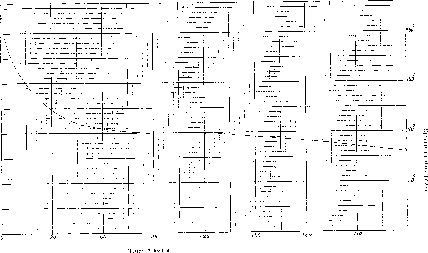
The second set of experiments was conducted at the same temperature, different proportions of koji and starch being used. The amounts of koji and starch used for the following table were 5 grams of starch to 20 grams of koji.
In this series the same specific rotatory power, 100.4° is attained in 68 hours, which it took 120 hours in the former series to arrive at, and the reduction is greater in the last series in 164 hours, than in 240 hours of the former. The reason of this lies in the larger proportion of koji used in the second than in the first series of experiments, but although four times as much koji was used, the rapidity of the action appears to be only about twice as great.
The third and fourth series of experiments were made at a temperature varying between 10° and 15°C, but otherwise they were conducted as before.
Figure 5 represents the first of these results in the form of a curve. It will be noticed that although the two series of experiments at 10-15°C were made to all appearance under exactly the same conditions, yet the reduction in the specific rotatory power at a given time is much greater in the second series. This may be accounted for in one of two ways. It may be that different portions even of the same preparation of koji differ in activity, or it may be that, although the limits of temperature in both cases were the same, the average temperature of the former series was higher than of the second set. That this might affect the results will be seen by reference to Figure 5 in which the inclination of the curve between 21-1/2 hours and 26 hours is greater than the average. This was undoubtedly the result of the solution during that interval having a higher temperature than the average of the whole time. These limits fell in the middle of the day when the temperature was 15° the whole time; if an examination of the liquid had not been made at the two periods mentioned this sudden drop would not have been observed, but the average inclination from the beginning to 21-1/2 hours would have appeared slightly greater. In the same way if the temperature had remained during one set of experiments more nearly 15° and in the other more nearly 10° during the whole time, the action might be expected to be more rapid in the former than in the latter.
Figure 5: Curve showing action of koji extract on gelatinized starch at 10-15°C
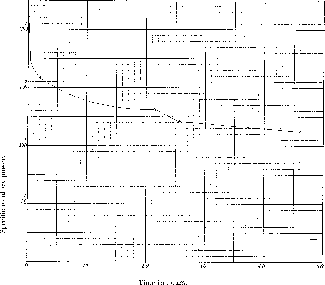
From these experiments we may understand what occurs during the mashing operations in sake making. At first they are conducted at even a lower temperature than 4°C, and this is interesting because it shows that the activity of the diastase in koji is not destroyed at low temperatures, even at 0°C.
At a higher temperature the reduction in the specific rotatory power of the solution goes on more rapidly, and although the sake brewer never uses temperatures so high as those of the succeeding experiments, it is of scientific interest to complete the record at all temperatures below that at which the diastase of koji is rendered inactive.
The experiments at higher temperatures were conducted in the following manner. The flask containing the mixture was immersed in a water bath and kept at the specified temperature, samples being taken at stated intervals. The portion used for determining the total solid matter in solution from its specific gravity was rapidly cooled by means of ice, and another portion in which the specific rotatory power was to be determined, was poured into a dry flask containing a little salicylic acid, as recommended by Brown and Heron3, and also rapidly cooled. Deduction was made for the amount of koji solution added as in the previous experiments.
The two next series of experiments were conducted at 40°C and only differ in the relative proportions of starch and koji used. The first series used 10 grams of starch to 5 grams of koji; the second used 10 grams of starch to 10 grams of koji.
In Figure 6 these results are represented in a graphic manner. The difference between the two sets lies in the fact that in the latter twice as much koji is used as in the former, and the result is that at any given time the diminution in the specific rotatory power is greater in the latter. Further, the general form of the two curves is similar and there is no evidence of any sudden break in the curve, such as in Brown and Heron's experiments indicates a definite chemical equation. Such a break could not be expected, seeing that the action of koji solution upon maltose would tend to disguise such reactions, by rubbing down the corners, as it were. Table 21 gives the results of a similar experiment made at 45°C.
Figure 6: Curve showing action of koji extract on gelatinized starch at 40°C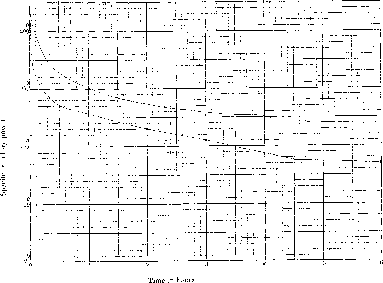
In the curve in Figure 7 which represents these results graphically, it will be noticed that during the first five minutes the fall in the specific rotatory power is very rapid until it arrives at [a]j = 142.6° after which it proceeds very nearly a straight line until the specific rotatory power equals 106°, after which it remains almost the same, until after a fresh addition of koji, which causes a reduction to 88°. As the rate of reduction after the addition of a fresh quantity of koji is very nearly the same as at first, as is shown by the similarity in the inclinations of the curve, it is evident that the koji first added had been nearly exhausted when the specific rotatory power of 106° was attained.
Figure 7: Curve showing action of koji extract on gelatinized starch at 45°C
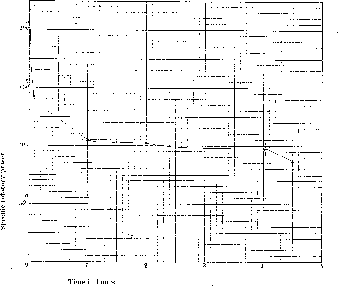
At a higher temperature, 60°C, the activity of the koji solution is very soon exhausted, as will be seen from the following results (Table 21), and from the curve in Figure 8. 10 grams of starch and 10 grams of koji were used.
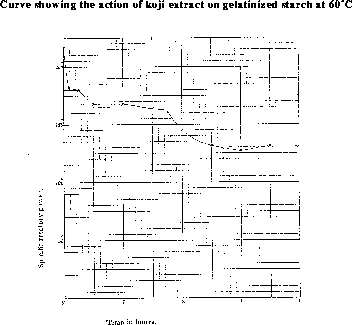
The number found at 15 minutes is doubtless incorrect. After half an hour had elapsed, and the specific rotatory power had diminished to 168°, the action appeared to cease, until a fresh addition of koji was made, when it fell at a similar rate, and for nearly the same time as at first. The high temperature, therefore, very quickly renders the diastase of koji inactive.
At a temperature of 70°C practically no solution of starch took place from which it may be concluded that a temperature between 60° and 70°C renders it completely inert. The diastase of malt is not killed until between 80° and 81°, which constitutes another point of difference between the two. The two bodies resemble one another in this, that the loss of activity is accompanied by the appearance of a distinct precipitate, consisting of albumenoid matter that has been coagulated by heat. Messrs. Brown and Heron state that "Every stage in the coagulation of malt extract by heat is attended with a distinct modification of its starch transforming power; and conversely, we have never been able to discover any modification in starch transforming power which is not attended with distinct coagulation. In addition to this, at 80-81°, the point at which the diastatic power of malt extract is destroyed, nearly the whole of the coagulable albumenoids have been precipitated. We are consequently led to conclude that the diastatic power is a function of the coagulable albumenoids themselves, and is not due as has been generally supposed, to the presence of a distinctive transforming agent."4
We have already seen that the principal change which rice undergoes in its conversion to koji is the alteration in the nature of the albumenoid matter which becomes more easily degraded and soluble in water; taking this in connection with the destruction of the active properties of the solution at a temperature corresponding to that at which the albumenoid matter becomes coagulated, we are led to the conclusion that there is a similar connection between the presence of soluble albumenoids and the activity of the solution of koji which seems to hold in the case of malt extract.
[Top] [Prev] [Next] [Bottom]
1
Journ. Chem. Soc, 1876, vol. II., p. 125, also 1879. Trans. p.770.
2
Ibid., 1879 Trans. p. 596.
3
loc.cit., 1879, Trans, p. 630.
4
Brown and Heron, loc.cit., p. 651.
stevens@stsci.edu
 6 (C12H20O10)
6 (C12H20O10) + 4 H2O = 4 C12H22O11
+ 4 H2O = 4 C12H22O11 + 2 C12H20O10
+ 2 C12H20O10
 6 (C12H20O10)
6 (C12H20O10) + 3 H2O = 3 C12H22O11
+ 3 H2O = 3 C12H22O11 + 3 C12H20O10
+ 3 C12H20O10
 6 (C12H20O10)
6 (C12H20O10) + 2 H2O = 2 C12H22O11
+ 2 H2O = 2 C12H22O11 + 4 C12H20O10
+ 4 C12H20O10
 6 (C12H20O10)
6 (C12H20O10) + H2O = C12H22O11
+ H2O = C12H22O11 + 5 C12H20O10
+ 5 C12H20O10
 10 (C12H20O10) + H2O = C12H22O11 + 9 C12H20O10 (Erythro-dextrin
10 (C12H20O10) + H2O = C12H22O11 + 9 C12H20O10 (Erythro-dextrin  )
) 10 (C12H20O10) + 2 H2O = 2 C12H22O11 + 8 C12H20O10 (Erythro-dextrin
10 (C12H20O10) + 2 H2O = 2 C12H22O11 + 8 C12H20O10 (Erythro-dextrin  )
) 10 (C12H20O10) + 3 H2O = 3 C12H22O11 + 7 C12H20O10 (Achroo-dextrin
10 (C12H20O10) + 3 H2O = 3 C12H22O11 + 7 C12H20O10 (Achroo-dextrin  )
) 10 (C12H20O10) + 4 H2O = 4 C12H22O11 + 6 C12H20O10 (Achroo-dextrin
10 (C12H20O10) + 4 H2O = 4 C12H22O11 + 6 C12H20O10 (Achroo-dextrin  )
) 10 (C12H20O10) + 8 H2O = 8 C12H22O11 + 2 C12H20O10 (Achroo-dextrin
10 (C12H20O10) + 8 H2O = 8 C12H22O11 + 2 C12H20O10 (Achroo-dextrin  )
) 10 (C12H20O10) + 9 H2O = 9 C12H22O11 + C12H20O10 (Achroo-dextrin
10 (C12H20O10) + 9 H2O = 9 C12H22O11 + C12H20O10 (Achroo-dextrin  )
)





